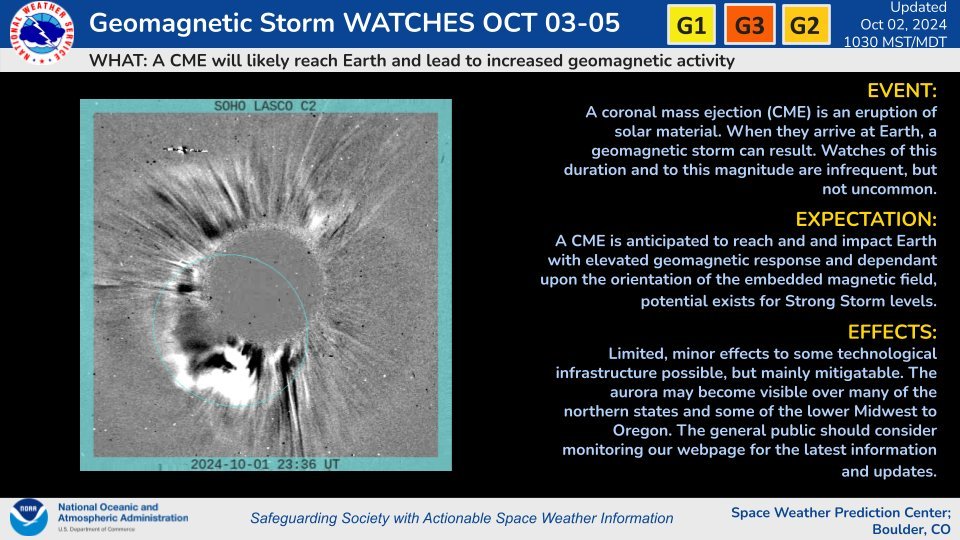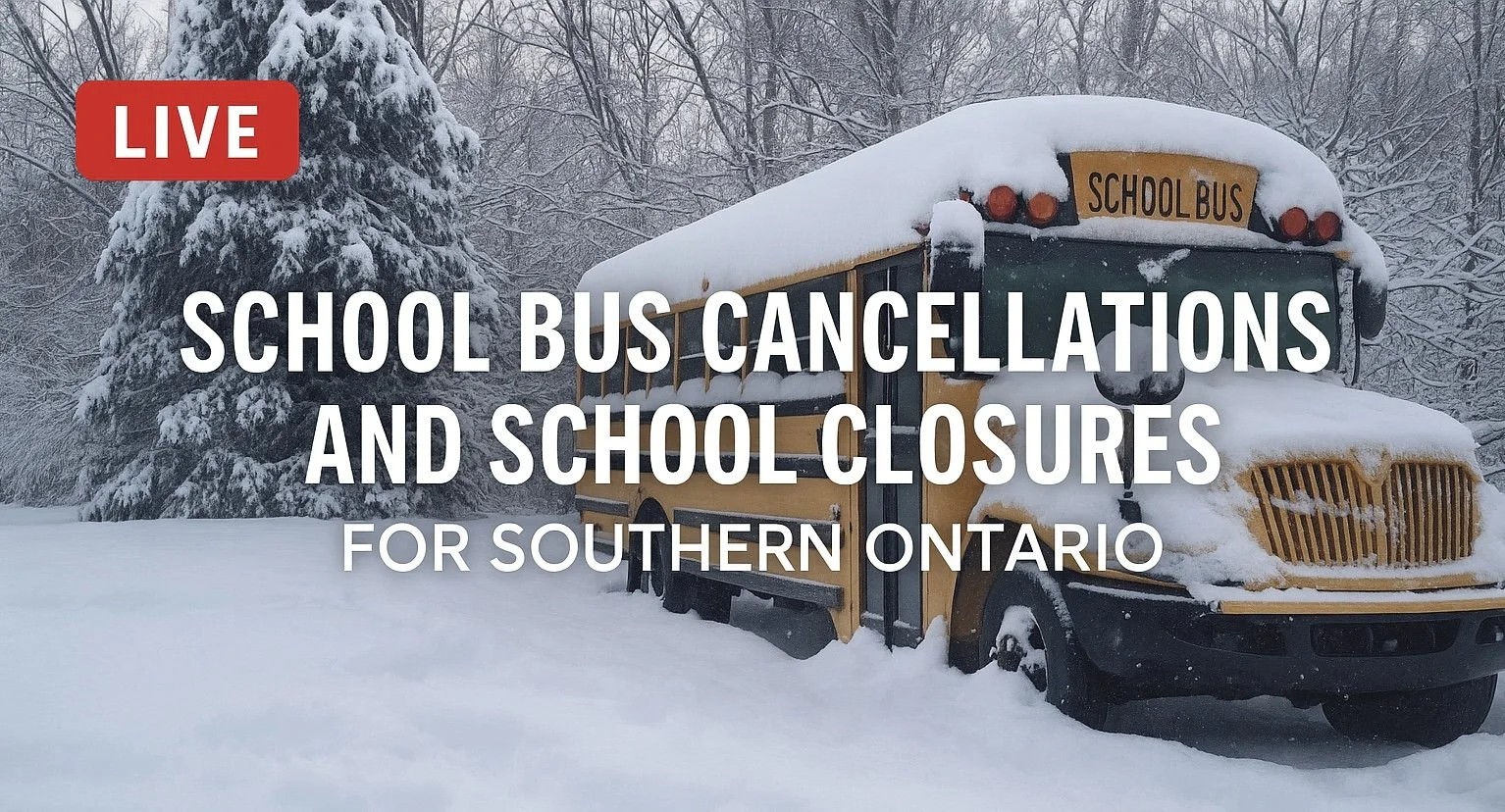‘Strong’ Geomagnetic Storm Takes Aim at Earth; Northern Lights May Dazzle the Skies Across Canada on Thursday & Friday
/One of the most powerful solar flares in recent years erupted from the sun on Tuesday evening, classified as an X7.1 flare. Initially, it was unclear whether this flare had produced a coronal mass ejection (CME), which is a large expulsion of plasma and magnetic field from the sun’s corona.
However, data that came in later confirmed that a CME was indeed produced and, more importantly, appears to be Earth-directed. This means that the CME is expected to impact our planet, setting off the possibility of a ‘strong’ geomagnetic storm and potentially bringing the northern lights much farther south than usual across Canada to close out the week.
#BREAKING: A powerful X7.1 solar flare is currently erupting from the sun, making it one of the strongest flares we’ve seen in recent years.
— Instant Weather Ontario ⚡️ (@IWeatherON) October 1, 2024
We’re still waiting for confirmation on whether an Earth-directed coronal mass ejection (CME) is associated with this flare. If there is,… https://t.co/V5kpdUJDmn
The exact timing of the CME's arrival, however, remains somewhat uncertain. Forecast models suggest it could arrive anywhere between late Thursday and early Saturday. The CME might even come in multiple waves, according to the latest data.
If this happens, we could be in for two consecutive nights of auroras lighting up the skies—if the conditions align perfectly! While the Northern Lights are never guaranteed, the next couple of nights offer a decent chance to catch a breathtaking display, depending on where you are located.
SOURCE: SPACE WEATHER PREDICTION CENTER
The Space Weather Prediction Center (SWPC) has issued a Geomagnetic Storm Watch, with the CME expected to reach Earth between Thursday and Saturday. Based on the latest observations, this CME could trigger G1 (minor) to G3 (strong) geomagnetic storm conditions.
The SWPC’s latest forecast predicts that a 'strong' (G3) geomagnetic storm may unfold late Thursday evening into the early overnight hours, followed by a potentially more prolonged geomagnetic storm ranging from ‘moderate’ (G2) to ‘strong’ (G3) on Friday night into Saturday morning.
A G2 to G3 storm is strong enough to make the northern lights visible across much of Canada, especially if conditions are just right. In the past, storms of this magnitude have allowed the auroras to be seen as far south as Southern Ontario, and in some cases, even into the northern United States. In fact, the SWPC notes the possibility of the auroras being visible as far south as parts of the lower Midwest and Oregon in the U.S.
That said, space weather forecasting comes with some inherent uncertainty. The exact timing of a CME’s arrival can vary, and its intensity is often unknown until a few hours before it strikes Earth. There is usually a 12- to 24-hour window for the CME’s arrival, which means that although the current forecast favours North American viewing on Thursday and Friday nights, the event could just as easily occur during daylight hours, rendering it invisible to viewers in North America and giving those in Europe a better chance at catching the show instead.
Aside from timing, cloud cover will also be a crucial factor in determining whether you'll have a good view of the northern lights. As of now, fairly clear skies are expected across much of southern Canada on Thursday night. Specifically, areas of Atlantic Canada, Southern Quebec, and Southern Ontario are forecasted to have little to no cloud cover during the overnight hours, which is ideal for aurora viewing.
Further north, however, there could be widespread cloud cover that might obstruct the view around James Bay in Northern Ontario and Quebec. Similarly, Northwestern Ontario could see some cloudiness, with the exception of a pocket near the International border around Thunder Bay.
In Southern Manitoba, skies look clear south of the Interlake region, though clouds will likely impact Northern Manitoba and Saskatchewan.
For Western Canada, Southern Saskatchewan and Southeastern Alberta are expected to have the clearest conditions. Meanwhile, much of British Columbia, along with central and northern Alberta, could see cloud cover that may limit visibility.
Check out our free app, Instant Weather for a more in-depth cloud coverage forecast specific to your exact location.
If you’re planning to watch for the auroras, another factor working in your favour this time around is the moon phase. Unlike last month’s aurora event, the moon is currently near 0% full, as we’ve just had a new moon on Tuesday night. This means that there won’t be any moonlight competing with the northern lights, making it easier to spot even faint auroras.
When it comes to where the northern lights might be visible, it all depends on the strength of the geomagnetic storm and how it interacts with Earth’s magnetic field. Historically, during a 'strong' (G3) storm, auroras are most visible across northern Canada, including Northern Quebec, Far Northern Ontario, the Prairies, and parts of British Columbia. In these regions, the northern lights could be visible overhead and bright enough to see with the naked eye.
In southern regions, including Northeastern Ontario (Sault Ste. Marie, Sudbury, and North Bay), as well as parts of Quebec, there’s a chance of seeing the auroras overhead or just above the horizon.
This could extend into northern parts of Southern Ontario, including Muskoka, Algonquin Park, and the Ottawa Valley. However, depending on the storm's strength, auroras may only be visible along the northern horizon, and you might need a camera to capture them, as they may not be strong enough for the naked eye.
For the rest of Southern Ontario and into Atlantic Canada, if the auroras appear, they will likely be on the northern horizon. Here, too, you may need a camera or smartphone to capture the lights, as they may be too faint to see without assistance.
Remember, light pollution can greatly impact your ability to see the northern lights, especially in urban areas. For the best viewing experience, it’s essential to get away from city lights. A resource like DarkSiteFinder can help you locate areas with low light pollution for optimal aurora viewing.
Northern Lights Timing
Many are accustomed to the precise scheduling of weather events, from thunderstorms and winter weather to solar eclipses, where timing is crucial. It’s understandable, then, that there’s a desire for a similar pinpoint timing for the best viewing of the aurora. However, the reality of predicting the best time to view the northern lights is not so straightforward.
Here’s the deal: Unlike weather events driven by terrestrial conditions, the aurora is influenced by solar activity, which is far less predictable. We can estimate that the northern lights are best viewed from just after sunset to just before sunrise, provided the skies are dark and clear. Beyond that, precise timing for peak aurora activity is challenging to forecast with current technology.
Space weather forecasting doesn't yet allow us to predict exactly when solar energy will impact Earth. We know it's coming, but how and when it interacts with our planet's magnetic field can vary. Often, we only have a few hours' notice before the solar energy is detected by satellites.
Furthermore, the intensity of the northern lights can fluctuate significantly over short periods. You might have noticed this variance if you've observed the lights before—periods of dim activity suddenly bursting into vibrant colors. This is due to the variable concentration of solar particles interacting with our atmosphere.
While we can inform you a few hours ahead when conditions are likely to be good, predicting the exact peak of aurora activity is akin to forecasting the peak of a meteor shower; we know the best night but not the best hour.
















